Friction Determination by Atomic Force Microscopy in Field of Biochemical Science
Abstract
:1. Introduction
2. Mechanism of Friction Mechanics and Measurement Principle at Nanoscale by Using AFM
3. Friction Measurement by AFM
3.1. Frictional Morphology
3.2. Friction Curve
3.3. Friction Motion Process
3.4. Other AFM Measurements on Friction
4. Conclusions
Author Contributions
Funding
Acknowledgment
Conflicts of Interest
References
- Li, Y.; Jiang, Z.; Hong, Q. Nanotechnology Aim to Disease Diagnosis and Treatment. Life Sci. Instrum. 2016, 14, 18–22. [Google Scholar] [CrossRef] [PubMed]
- Hsu, H.F.; Tseng, C.H.; Chen, T.H. Formation of epitaxial NiSi2 nanowires on Si(100) surface by atomic force microscope nanolithography. J. Nanosci. Nanotechnol. 2010, 10, 4533–4537. [Google Scholar] [CrossRef] [PubMed]
- Martin, C.; Rius, G.; Borrise, X.; Pérez-Murano, F. Nanolithography on thin layers of PMMA using atomic force microscopy. Nanotechnology 2005, 16, 1016. [Google Scholar] [CrossRef]
- Chen, Y.J.; Hsu, J.H.; Lin, H.N. Fabrication of metal nanowires by atomic force microscopy nanoscratching and lift-off process. Nanotechnology 2005, 16, 1112–1115. [Google Scholar] [CrossRef] [Green Version]
- Hsu, J.H.; Lin, C.Y.; Lin, H.N. Fabrication of metallic nanostructures by atomic force microscopy nanomachining and lift-off process. J. Vac. Sci. Technol. B 2004, 22, 2768–2771. [Google Scholar] [CrossRef]
- Okajima, T.; Sekiguchi, H.; Arakawa, H.; Ikai, A. Self-oscillation technique for AFM in liquids. Appl. Surf. Sci. 2003, 210, 68–72. [Google Scholar] [CrossRef]
- Kageshima, M.; Jensenius, H.; Dienwiebel, M.; Nakayama, Y.; Tokumoto, H.; Jarvis, S.P.; Oosterkamp, T.H. Noncontact atomic force microscopy in liquid environment with quartz tuning fork and carbon nanotube probe. Appl. Surf. Sci. 2002, 188, 440–444. [Google Scholar] [CrossRef]
- Song, Y.; Bhushan, B. Finite-element vibration analysis of tapping-mode atomic force microscopy in liquid. Ultramicroscopy 2007, 107, 1095–1104. [Google Scholar] [CrossRef] [PubMed]
- Hendrych, A.; Kubínek, R.; Zhukov, A.V. The magnetic force microscopy and its capability for nanomagnetic studies—The short compendium. Modern Res. Educ. Top. Microsc. 2007, 2, 805–811. [Google Scholar]
- Zhang, F.M.; Liu, X.C.; Gao, J.; Wu, X.S.; Du, Y.W. Investigation on the magnetic and electrical properties of crystalline Mn0.05Si0.95 films. Appl. Phys. Lett. 2004, 85, 786–788. [Google Scholar] [CrossRef]
- Ohlsson, R.; Wihlborg, A.; Westberg, H. The accuracy of fast 3D topography measurements. Int. J. Mach. Tools Manuf. 2001, 41, 1899–1907. [Google Scholar] [CrossRef]
- Lekka, M.; Laidler, P.; Ignacak, J.; Łabędź, M.; Lekki, J.; Struszczyk, H.; Stachura, Z.; Hrynkiewicz, A.Z. The effect of chitosan on stiffness and glycolytic activity of human bladder cells. Biochim. Biophys. Acta Mol. Cell Res. 2001, 1540, 127–136. [Google Scholar] [CrossRef]
- Cretegny, L.; Saxena, A. AFM characterization of the evolution of surface deformation during fatigue in polycrystalline copper. Acta Mater. 2001, 49, 3755–3765. [Google Scholar] [CrossRef]
- Man, J.; Petrenec, M.; Obrtlík, K.; Polák, J. AFM and TEM study of cyclic slip localization in fatigued ferritic X10CrAl24 stainless steel. Acta Mater. 2004, 52, 5551–5561. [Google Scholar] [CrossRef]
- Vengudusamy, B.; Mufti, R.A.; Lamb, G.D.; Green, J.H.; Spikes, H.A. Friction properties of DLC/DLC contacts in base oil. Tribol. Int. 2011, 44, 922–932. [Google Scholar] [CrossRef]
- Gaisinskayakipnis, A.; Klein, J. Normal and Frictional Interactions between Liposome-Bearing Biomacromolecular Bilayers. Biomacromolecules 2016, 17, 2591. [Google Scholar] [CrossRef] [PubMed]
- Zhang, F.; Meng, B.; Geng, Y.; Zhang, Y.; Li, Z. Friction behavior in nanoscratching of reaction bonded silicon carbide ceramic with Berkovich and sphere indenters. Tribol. Int. 2016, 97, 21–30. [Google Scholar] [CrossRef]
- Dawood, H.I.; Mohammed, K.S.; Rahmat, A.; Uday, M.B. The influence of the surface roughness on the microstructures and mechanical properties of 6061 Aluminium alloy using friction stir welding. Surf. Coat. Technol. 2016, 270, 272–283. [Google Scholar] [CrossRef]
- Westlund, V.; Heinrichs, J.; Olsson, M.; Jacobson, S. Investigation of material transfer in sliding friction-topography or surface chemistry. Tribol. Int. 2016, 100, 213–223. [Google Scholar] [CrossRef]
- Mokhtari, M.; Schipper, D.J.; Vleugels, N.; Noordermeer, J.W.M. Transversely isotropic viscoelastic materials: Contact mechanics and friction. Tribol. Int. 2016, 97, 116–123. [Google Scholar] [CrossRef]
- Chen, Y.; Zeng, G.; Chen, S.S.; Feng, Q.; Chen, Z.W. AFM force measurements of the gp120–sCD4 and gp120 or CD4 antigen–antibody interactions. Biochem. Biophys. Res. Commun. 2011, 407, 301–306. [Google Scholar] [CrossRef] [PubMed] [Green Version]
- Wakayama, J.; Sugiyama, S. Evaluation of temperature effect on the interaction between β-lactoglobulin and anti-β-lactoglobulin antibody by atomic force microscopy. Biochemistry 2012, 51, 32–42. [Google Scholar] [CrossRef] [PubMed]
- Kim, B.-H.; Palermo, N.Y.; Lovas, S.; Zaikova, T.; Keana, J.F.W.; Lyubchenko, Y.L. Single-molecule atomic force microscopy force spectroscopy study of Aβ-40 interactions. Biochemistry 2011, 50, 5154–5162. [Google Scholar] [CrossRef] [PubMed]
- Yu, J.; Warnke, J.; Lyubchenko, Y.L. Nanoprobing of α-synuclein misfolding and aggregation with atomic force microscopy. Nanomed. Nanotechnol. Biol. Med. 2011, 7, 146–152. [Google Scholar] [CrossRef] [PubMed]
- Lovas, S.; Zhang, Y.; Yu, J.; Lyubchenko, Y.L. Molecular Mechanism of Misfolding and Aggregation of Aβ (13–23). J. Phys. Chem. B 2013, 117, 6175–6186. [Google Scholar] [CrossRef] [PubMed]
- Beckwitt, E.; Kong, M.; Van Houten, B. Studying Protein-DNA Interactions Using Atomic Force Microscopy. Semin. Cell Dev. Biol. 2017, 73, 220–230. [Google Scholar] [CrossRef] [PubMed]
- Wang, H.; Yang, Y.; Schofield, M.J.; Du, C.; Fridman, Y.; Lee, S.D.; Larson, E.D.; Drummond, J.T.; Alani, E.; Hsieh, P.; et al. DNA Bending and Unbending by MutS Govern Mismatch Recognition and Specificity. Proc. Natl. Acad. Sci. USA 2003, 100, 14822–14827. [Google Scholar] [CrossRef] [PubMed]
- Josephs, E.A.; Zheng, T.; Marszalek, P.E. Atomic force microscopy captures the initiation of methyl-directed DNA mismatch repair. DNA Repair 2015, 35, 71–84. [Google Scholar] [CrossRef] [PubMed] [Green Version]
- Thorén, P.-A.; de Wijn, A.S.; Borgani, R.; Forchheimer, D.; Haviland, D.B. Imaging high-speed friction at the nanometer scale. Nat. Commun. 2016, 7, 13836. [Google Scholar] [CrossRef] [PubMed] [Green Version]
- Lv, Z.; Wang, J.; Chen, G.; Deng, L. Imaging and determining friction forces of specific interactions between human IgG and rat anti-human IgG. J. Biol. Phys. 2011, 37, 417–427. [Google Scholar] [CrossRef] [PubMed] [Green Version]
- Wang, H.; Gee, M.L. AFM lateral force calibration for an integrated probe using a calibration grating. Ultramicroscopy 2014, 136, 193–200. [Google Scholar] [CrossRef] [PubMed]
- Marsden, A.J.; Phillips, M.; Wilson, N.R. Friction force microscopy: A simple technique for identifying graphene on rough substrates and mapping the orientation of graphene grains on copper. Nanotechnology 2013, 24, 255704. [Google Scholar] [CrossRef] [PubMed]
- Persson, B.N.J. Sliding Friction-Physical Principles and Applications; Springer: Berlin, Germany, 2000. [Google Scholar]
- Muser, M.H.; Urbakh, M.; Robbins, M.O. Statistical mechanics of static and low-velocity kinetic friction. Adv. Chem. Phys. 2003, 126, 187–272. [Google Scholar]
- Urbakh, M.; Klafter, J.; Gourdon, D.; Israelachvili, J. The nonlinear nature of friction. Nature 2004, 430, 525–528. [Google Scholar] [CrossRef] [PubMed]
- Braun, O.M.; Naumovets, A.G. Nanotribology-microscopic mechanisms of friction. Surf. Sci. Rep. 2006, 60, 79–158. [Google Scholar] [CrossRef]
- Binnig, G.; Quate, C.F.; Gerber, C. Atomic force microscope. Phys. Rev. Lett. 1986, 56, 930–933. [Google Scholar] [CrossRef] [PubMed]
- Samyn, P.; Schoukens, G.; Baets, P.D. Micro- to nanoscale surface morphology and friction response of tribological polyimide surfaces. Appl. Surf. Sci. 2010, 256, 3394–3408. [Google Scholar] [CrossRef]
- Bhushan, B.; Israelachvili, J.N.; Landman, U. Nanotribology: Friction, wear and lubrication at the atomic scale. Nature 1995, 374, 607–616. [Google Scholar] [CrossRef]
- Achanta, S.; Drees, D.; Celis, J.P. Friction from nano to macroforce scales analyzed by single and multiple-asperity contact approaches. Surf. Coat. Technol. 2008, 202, 6127–6135. [Google Scholar] [CrossRef]
- Dong, Y.; Vadakkepatt, A.; Martini, A. Analytical Models for Atomic Friction. Tribol. Lett. 2011, 44, 367. [Google Scholar] [CrossRef]
- Szlufarska, I.; Chandross, M.; Carpick, R.W. Recent advances in single-asperity nanotribology. J. Phys. D-Appl. Phys. 2008, 41, 123001. [Google Scholar] [CrossRef]
- Krylov, S.Y.; Jinesh, K.B.; Valk, H.; Dienwiebel, M.; Frenken, J.W.M. Thermally induced suppression of friction at the atomic scale. Phys. Rev. E 2005, 71, 065101(R). [Google Scholar] [CrossRef] [PubMed]
- Sang, Y.; Dube, M.; Grant, M. Thermal effects on atomic friction. Phys. Rev. Lett. 2001, 87, 174301. [Google Scholar] [CrossRef] [PubMed]
- Ruan, J.A.; Bhushan, B. Atomic-scale friction measurements using friction force microscopy. Part 1: General principles and new measurement techniques. J. Tribol. 1994, 116, 378–388. [Google Scholar] [CrossRef]
- Guo, Y.B.; Wang, D.G.; Zhang, S.W. Adhesion and friction of nanoparticles/polyelectrolyte multilayer films by AFM and micro-tribometer. Tribol. Int. 2011, 44, 906–915. [Google Scholar] [CrossRef]
- Smith, J.R.; Swift, J.A. Lamellar subcomponents of the cuticular cell membrane complex of mammalian keratin fibres show friction and hardness contrast by AFM. J. Microsc. 2002, 206, 182–193. [Google Scholar] [CrossRef] [PubMed] [Green Version]
- Bhushan, B.; Chen, N. AFM studies of environmental effects on nanomechanical properties and cellular structure of human hair. Ultramicroscopy 2006, 106, 755–764. [Google Scholar] [CrossRef] [PubMed]
- Maxwell, J.M.; Huson, M.G. Scanning probe microscopy examination of the surface properties of keratin fibres. Micron 2005, 36, 127–136. [Google Scholar] [CrossRef] [PubMed]
- Dupres, V.; Camesano, T.; Langevin, D.; Checco, A.; Guenoun, P. Atomic force microscopy imaging of hair: Correlations between surface potential and wetting at the nanometer scale. J. Colloid Interface Sci. 2004, 269, 329–335. [Google Scholar] [CrossRef] [PubMed]
- Gurden, S.P.; Monteiro, V.F.; Longo, E.; Ferreira, M.M.C. Quantitative analysis and classification of AFM images of human hair. J. Microsc. 2004, 215, 13–23. [Google Scholar] [CrossRef] [PubMed] [Green Version]
- Poletti, G.; Orsini, F.; Lenardi, C.; Barborini, E. A comparative study between AFM and SEM imaging on human scalp hair. J. Microsc. 2003, 211, 249–255. [Google Scholar] [CrossRef] [PubMed] [Green Version]
- Ngunjiri, J.; Garno, J.C. AFM-Based Lithography for Nanoscale Protein Assays. Anal. Chem. 2008, 80, 1361–1369. [Google Scholar] [PubMed]
- Gu, J.; Chi, M.Y.; Li, S.; Ca, C. Nanometric Protein Arrays on Protein-Resistant Monolayers on Silicon Surfaces. J. Am. Chem. Soc. 2004, 126, 8098–8099. [Google Scholar] [CrossRef] [PubMed]
- Fuierer, R.R.; Carroll, R.L.; Feldheim, D.L.; Gorman, C.B. Patterning Mesoscale Gradient Structures with Self-Assembled Monolayers and Scanning Tunneling Microscopy Based Replacement Lithography. Adv. Mater. 2002, 14, 154–157. [Google Scholar] [CrossRef]
- Zhang, Y.; Berger, R.; Butt, H. Dip-Pen Nanolithography. Science 1999, 283, 661. [Google Scholar]
- Péter, M.; Li, X.M.; Huskens, J.; Reinhoudt, D.N. Catalytic probe lithography: Catalyst-functionalized scanning probes as nanopens for nanofabrication on self-assembled monolayers. J. Am. Chem. Soc. 2004, 126, 11684–11690. [Google Scholar] [CrossRef] [PubMed]
- Xu, S.; Miller, S.; Laibinis, P.E.; Liu, G.Y. Fabrication of nanometer scale patterns within self-assembled monolayers using nanografting. Langmuir 1999, 21, 7244–7251. [Google Scholar] [CrossRef]
- Ployon, S.; Morzel, M.; Belloir, C.; Bonnotte, A.; Bourillot, E.; Briand, L.; Lesniewska, E.; Lherminier, J.; Aybeke, E.; Canon, F. Mechanisms of astringency: Structural alteration of the oral mucosal pellicle by dietary tannins and protective effect of b PRPs. Food Chem. 2018, 253, 79–87. [Google Scholar] [CrossRef] [PubMed]
- Oguchi, T.; Sakai, K.; Sakai, H.; Abe, M. AFM surface morphology and friction force studies of microscale domain structures of binary phospholipids. Colloids Surf. B Biointerfaces 2010, 79, 205–209. [Google Scholar] [CrossRef] [PubMed]
- Latorre, C.; Bhushan, B. Investigation of scale effects and directionality dependence on friction and adhesion of human hair using AFM and macroscale friction test apparatus. Ultramicroscopy 2006, 106, 720–734. [Google Scholar] [CrossRef] [PubMed]
- Ogletree, D.F.; Carpick, R.W.; Salmeron, M. Calibration of frictional forces in atomic force microscopy. Rev. Sci. Instrum. 1996, 67, 3298–3306. [Google Scholar] [CrossRef] [Green Version]
- Bhushan, B.; Ko, P.L. Introduction to Tribology. Appl. Mech. Rev. 2003, 56, B6. [Google Scholar] [CrossRef]
- Smith, J.R.; Tsibouklis, J.; Nevell, T.G.; Breakspear, S. AFM friction and adhesion mapping of the substructures of human hair cuticles. Appl. Surf. Sci. 2013, 285, 638–644. [Google Scholar] [CrossRef]
- McNamee, C.E.; Yamamoto, S.; Kappl, M.; Butt, H.J.; Higashitani, K.; Dėdinaitė, A.; Claesson, P.M. Surface and friction forces between grafted polysaccharide layers in the absence and presence of surfactant. J. Colloid Interface Sci. 2011, 364, 351–358. [Google Scholar] [CrossRef] [PubMed]
- Lin, L.Y.; Kim, D.E.; Kim, W.K.; Jun, S.C. Friction and wear characteristics of multi-layer graphene films investigated by atomic force microscopy. Surf. Coat. Technol. 2011, 205, 4864–4869. [Google Scholar] [CrossRef]
- Bragg, W.H. An Introduction to Crystal Analysis; G. Bell & Son, Ltd.: London, UK, 1928. [Google Scholar]
- Zaidi, H.; Robert, F.; Paulmier, D. Influence of adsorbed gases on the surface energy of graphite: Consequences on the friction behaviour. Thin Solid Films 1995, 264, 46–51. [Google Scholar] [CrossRef]
- Yen, B.K. Influence of water vapor and oxygen on the tribology of carbon materials with sp2, valence configuration. Wear 1996, 192, 208–215. [Google Scholar] [CrossRef]
- Sirghi, L.; Tiron, V.; Dobromir, M. Friction at single-asperity contacts between hydrogen-free diamond-like carbon thin film surfaces. Diam. Relat. Mater. 2015, 52, 38–42. [Google Scholar] [CrossRef]
- Kienle, S.; Boettcher, K.; Wiegleb, L.; Urban, J.; Burgkart, R.; Lieleg, O.; Hugel, T. Comparison of friction and wear of articular cartilage on different length scales. J. Biomech. 2015, 48, 3052–3058. [Google Scholar] [CrossRef] [PubMed]
- Zhang, X.; Wu, C.; Che, H.; Hou, J.; Jia, J. Friction behavior of nano-textured polyimide surfaces measured by AFM colloidal probe. Appl. Surf. Sci. 2014, 320, 328–333. [Google Scholar] [CrossRef]
- Sotres, J.; Barrantes, A.; Arnebrant, T. Friction force spectroscopy as a tool to study the strength and lateral diffusion of protein layers. Langmuir 2011, 27, 9439–9448. [Google Scholar] [CrossRef] [PubMed]
- Li, H.; Somers, A.E.; Rutland, M.W.; Howlett, P.C.; Atkin, R. Combined Nano- and Macrotribology Studies of Titania Lubrication using Oil of Ionic liquid Mixtures. ACS Sustain. Chem. Eng. 2016, 4, 5005–5012. [Google Scholar] [CrossRef]
- Khan, M.S.; Dosoky, N.S.; Patel, D.; Weimer, J.; Williams, J.D. Lipid Bilayer Membrane in a Silicon Based Micron Sized Cavity Accessed by Atomic Force Microscopy and Electrochemical Impedance Spectroscopy. Biosensors 2017, 7, 26. [Google Scholar] [CrossRef] [PubMed]
- Khan, M.S.; Dosoky, N.S.; Mustafa, G.; Patel, D.; Berdiev, B.; Williams, J.D. Electrophysiology of Epithelial Sodium Channel (ENaC) Embedded in Supported Lipid Bilayer Using a Single Nanopore Chip. Langmuir 2017, 33, 13680–13688. [Google Scholar] [CrossRef] [PubMed]
- Kim, H.J.; Nguyen, G.H.; Ky, D.L.C.; Tran, D.K.; Jeon, K.J.; Chung, K.H. Static and kinetic friction characteristics of nanowire on different substrates. Appl. Surf. Sci. 2016, 379, 452–461. [Google Scholar] [CrossRef]
- Hausen, F.; Nielinger, M.; Ernst, S.; Baltruschat, H. Nanotribology at single crystal electrodes: Influence of ionic adsorbates on friction forces studied with AFM. Electrochim. Acta 2008, 53, 6058–6063. [Google Scholar] [CrossRef]
- Zhang, X.; Wang, X.; Kong, W.; Yi, G.; Jia, J. Tribological behavior of micro/nano-patterned surfaces in contact with AFM colloidal probe. Appl. Surf. Sci. 2011, 258, 113–119. [Google Scholar] [CrossRef]
- Podgaynyy, N.; Iqbal, S.; Baltruschat, H. Friction force microscopy at a regularly stepped Au(665) electrode: Anisotropy effects. Surf. Sci. 2015, 631, 67–72. [Google Scholar] [CrossRef]
- Liu, Z.; Wang, W.; Liu, L. Comparative study on friction force pattern anisotropy of graphite. Appl. Surf. Sci. 2015, 332 Pt 2, 473–479. [Google Scholar] [CrossRef]
- Jabbarzadeh, A. Friction anisotropy and asymmetry in self assembled monolayers. Tribol. Int. 2016, 102, 600–607. [Google Scholar] [CrossRef]

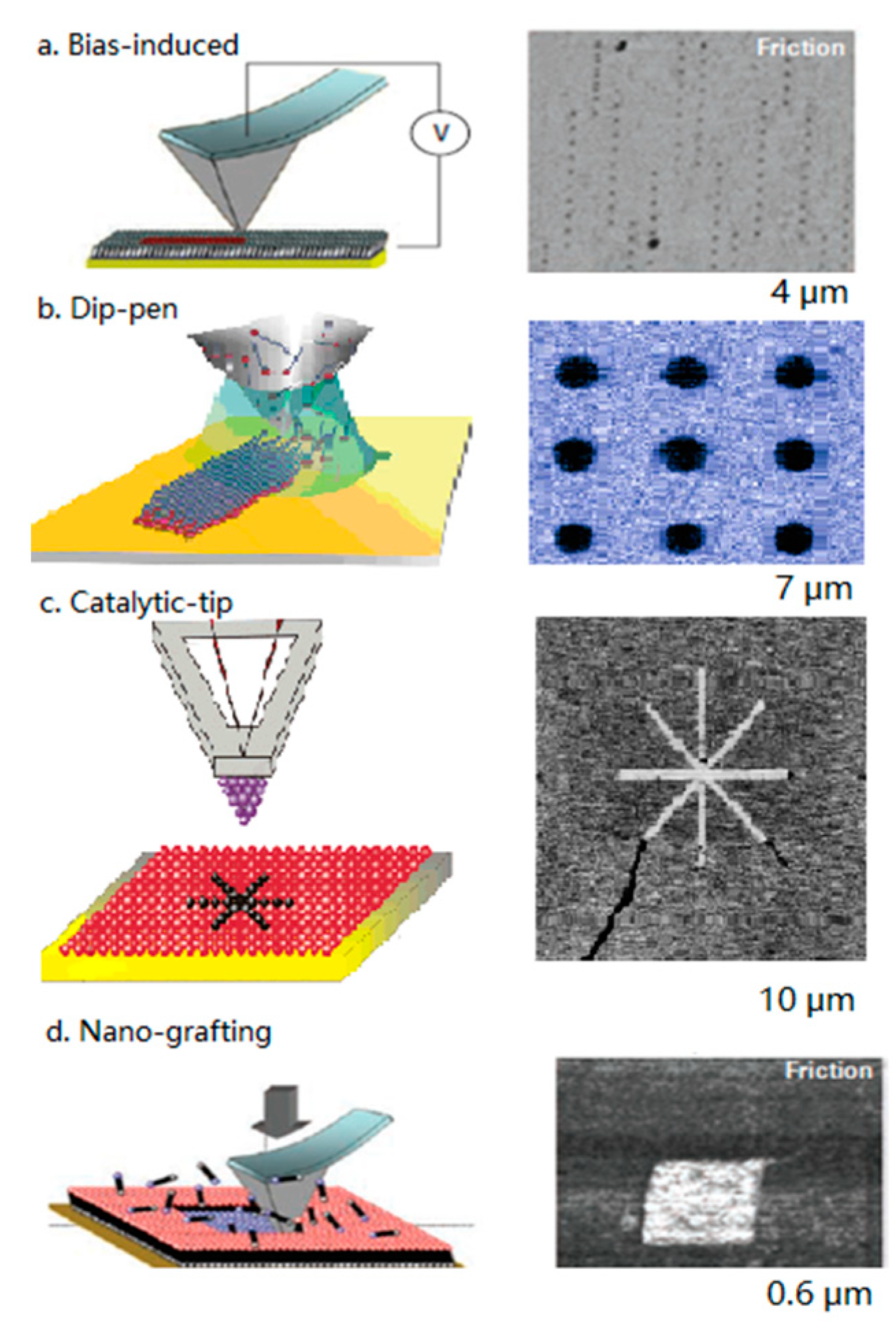
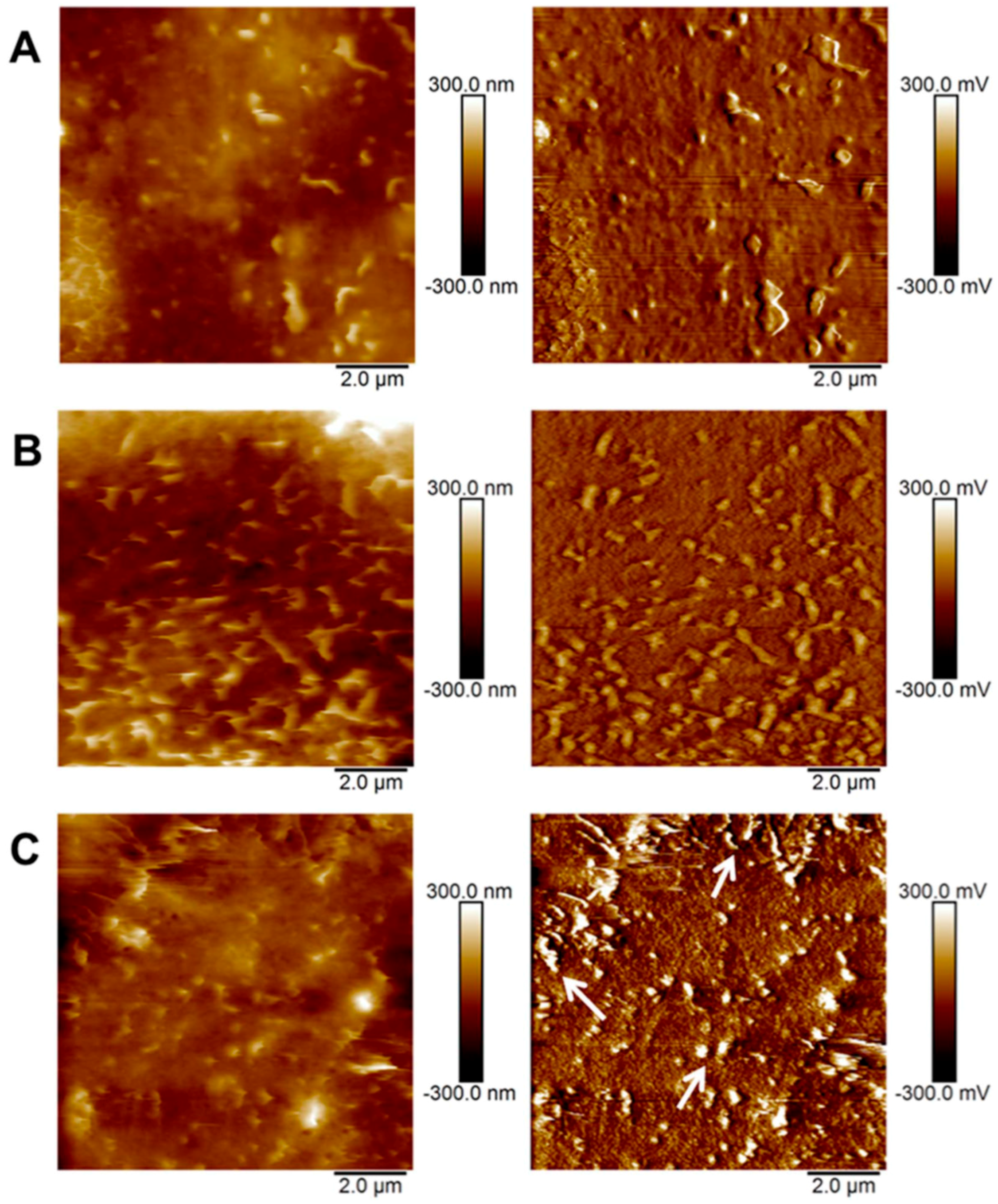

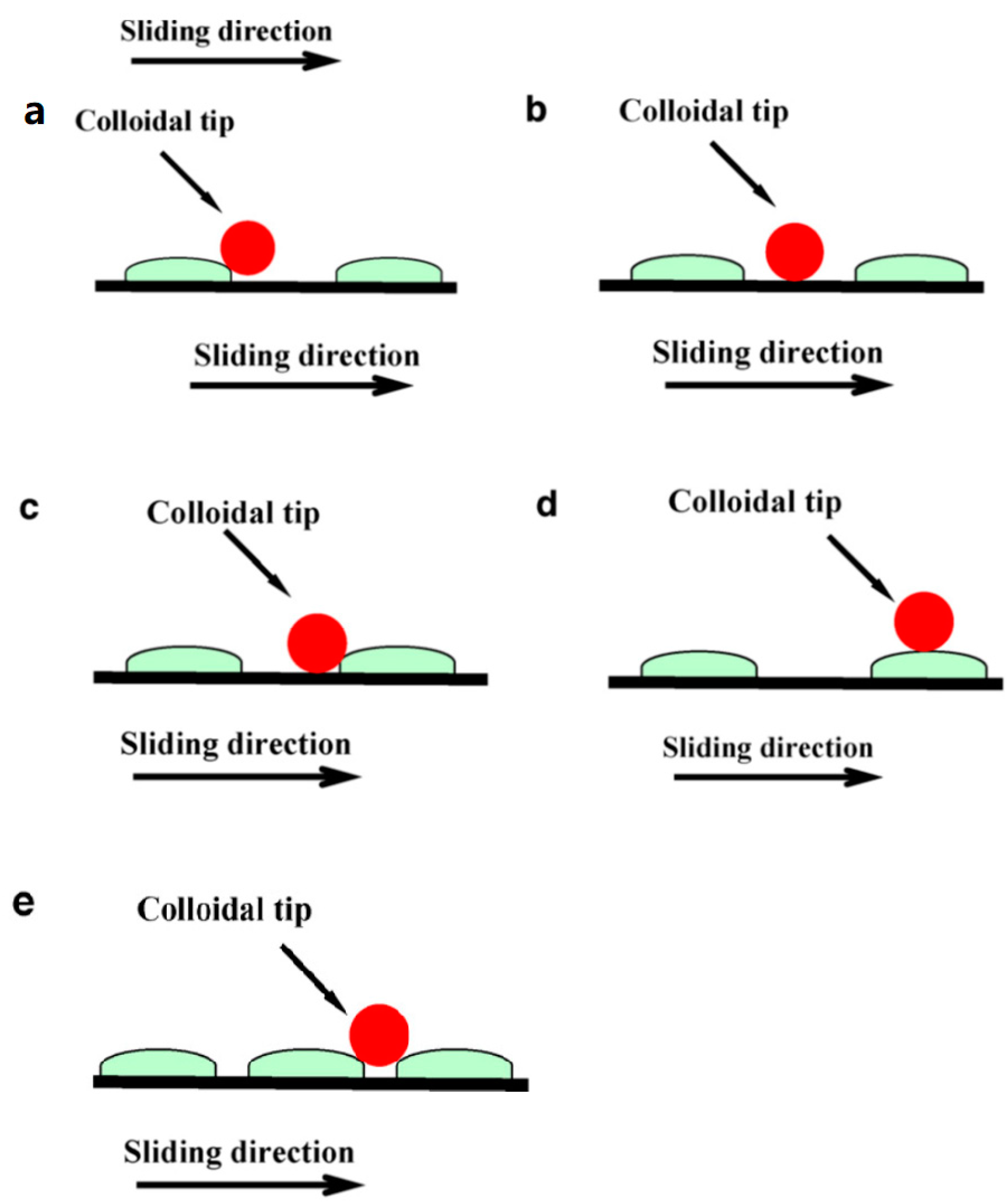
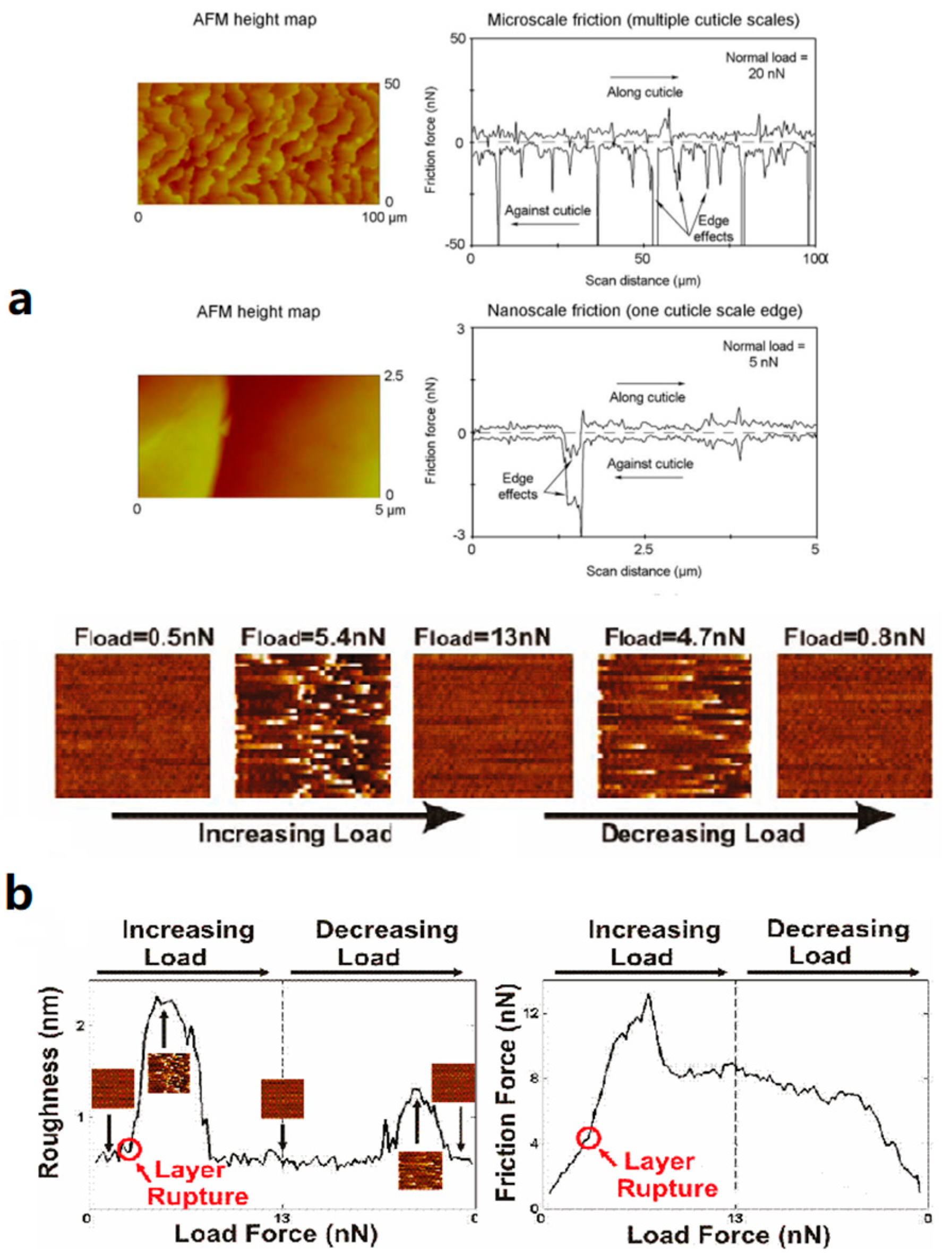
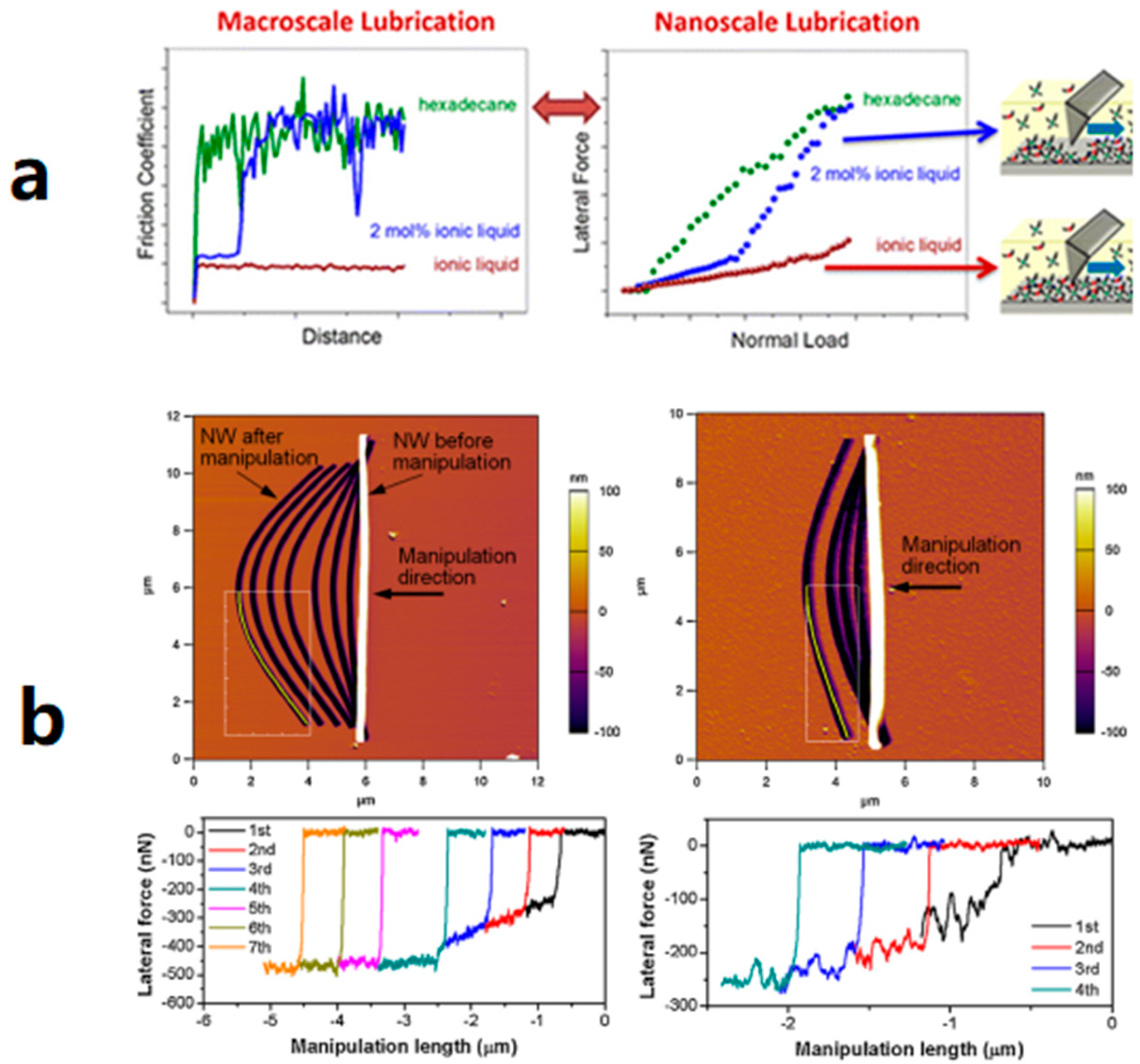
© 2018 by the authors. Licensee MDPI, Basel, Switzerland. This article is an open access article distributed under the terms and conditions of the Creative Commons Attribution (CC BY) license (http://creativecommons.org/licenses/by/4.0/).
Share and Cite
Wang, Y.; Wang, J. Friction Determination by Atomic Force Microscopy in Field of Biochemical Science. Micromachines 2018, 9, 313. https://doi.org/10.3390/mi9070313
Wang Y, Wang J. Friction Determination by Atomic Force Microscopy in Field of Biochemical Science. Micromachines. 2018; 9(7):313. https://doi.org/10.3390/mi9070313
Chicago/Turabian StyleWang, Yan, and Jianhua Wang. 2018. "Friction Determination by Atomic Force Microscopy in Field of Biochemical Science" Micromachines 9, no. 7: 313. https://doi.org/10.3390/mi9070313



